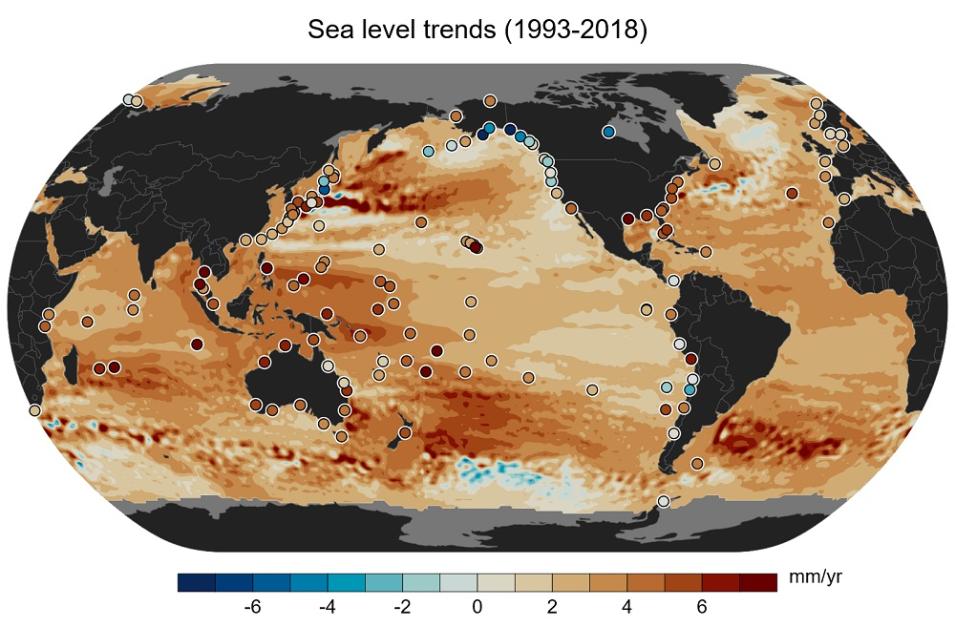As the world continues to warm, the impacts of sea level rise are shifting from questions of “if” this rise will impact coastal regions to “how much” of an impact this will have. According to a 2018 report by the Intergovernmental Panel on Climate Change (IPCC), the average global temperature is likely to rise 1.5°C between 2030 and 2052 if it continues to increase at the current rate (some regions already have reached or passed this critical threshold). Looking at the impacts of this on global sea level, the IPCC concludes that “Increasing warming amplifies the exposure of small islands, low-lying coastal areas and deltas to the risks associated with sea level rise for many human and ecological systems, including increased saltwater intrusion, flooding and damage to infrastructure (high confidence).”
Thompson is involved with numerous research efforts to better understand and help prepare for these expected impacts. As a member of NASA’s Sea Level Change Science Team, he is leading a study to quantify the impact of future sea level rise on the frequency of high-tide flooding along U.S. coastlines, including U.S. island territories. The results of this work will be incorporated into a dynamic, web-based tool hosted on NASA’s Sea Level Change portal designed to support decision-makers.
Closer to home, he and his students recently examined the factors that led to an unprecedented number of high-tide flooding events around Hawai‘i during the summer of 2017. Using satellite altimetry data, one of his graduate students documented how ocean eddies and the 2015 to 2016 El Niño event elevated sea levels to record heights and contributed to local flooding of roads and repeated over-wash of Waikiki beach in Oahu. These events led to further research into how the frequency of high tide flooding will evolve in Honolulu in coming decades and identified the potential for a four-fold increase in the number of flooding events in the 2030s to the 2040s.
Meanwhile, historic ice loss continues on the Greenland ice sheet. New data indicate that the ice sheet lost 12.5 billion tons of ice on August 1—the largest single-day ice loss by volume from the ice sheet ever recorded. The bottom line is that global average sea levels are rising, and more and more communities, regions, and nations will be impacted by this process. Thanks to the work and research of Thompson, his colleagues, and his students—aided by data collected by instruments aboard Earth observing satellites—the world will be better prepared to respond.
Representative data products used:
- Available through NASA’s PO.DAAC:
- NASA Making Earth Science Data Records for Use in Research Environments (MEaSUREs) Gridded Sea Surface Height Anomalies Version 1812 (doi:10.5067/SLREF-CDRV2)
- Global Mean Sea Level Trend from Integrated Multi-Mission Ocean Altimeters TOPEX/Poseidon, Jason-1, and OSTM/Jason-2 Version 4.2 (doi:10.5067/GMSLM-TJ142)
- JPL GRACE Mascon Ocean, Ice, and Hydrology Equivalent Water Height JPL Release 06 Version 1 (doi:10.5067/TEMSC-3MJ06)
- Available through the National Oceanic and Atmospheric Administration’s (NOAA) National Centers for Environmental Information:
- Sea level measured by tide gauges from global oceans as part of the Joint Archive for Sea Level (JASL) since 1846 (doi:10.7289/V5V40S7W)
Read about the research:
Thompson, P.R., Widlansky, M.J., Merrifield, M.A., Becker, J.M. & Marra, J.J. (2019). A Statistical Model for Frequency of Coastal Flooding in Honolulu, Hawai‘i, During the 21st Century. Journal of Geophysical Research: Oceans, 124(4): 2787–2802 (doi:10.1029/2018JC014741).
Yoon, H., Widlansky, M.J. & Thompson, P.R. (2018). “Nu‘a Kai: Flooding in Hawai‘i caused by a “stack” of oceanographic processes” [in “State of the Climate in 2017”]. Bulletin of the American Meteorological Society, 99(8): S88-S89. doi:10.1175/2018BAMSStateoftheClimate.1
Thompson, P.R., Hamlington, B.D., Landerer, F.W. & Adhikari, S. (2016). Are long tide gauge records in the wrong place to measure global mean sea level rise? Geophysical Research Letters, 43(19): 10403-10411. doi:10.1002/2016GL070552
Thompson, P.R., Piecuch, C.G., Merrifield, M.A., McCreary, J.P. & Firing, E. (2016). Forcing of recent decadal variability in the Equatorial and North Indian Ocean. Journal of Geophysical Research: Oceans, 121(9): 6762-6778. doi:10.1002/2016JC012132
For more information
Explore more Data User Profiles


